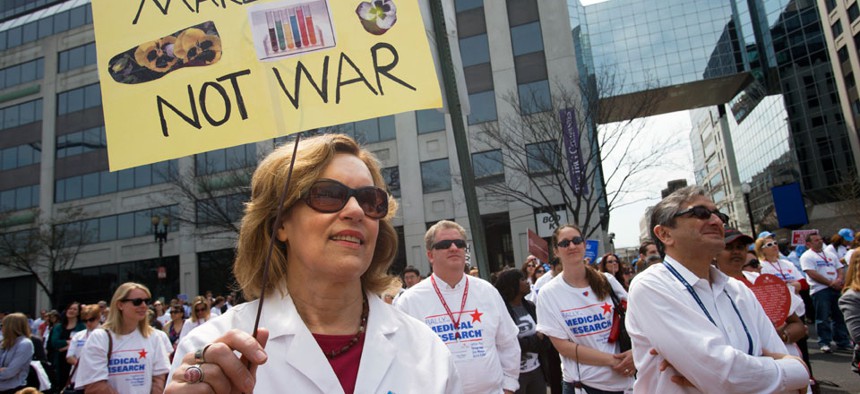
Lorraine Gudas, chair of pharmacology at Weill Cornell Medical College, and others, participate in a "Rally for Medical Research," Monday, April 8, 2013, in Washington. Jacquelyn Martin/AP
The Budget Deal: An Okay End to a Very Bad Year for Medical Research
Congress has offered some relief to NIH, but Francis Collins says lawmakers are still scrimping on essential science.
Two-thousand thirteen will go down as one of the least predictable—and most political—years in history for American medical research.
In the spring, sequestration—across-the-board budget cuts—wiped out more than 5 percent of fiscal-year 2013 budgets of government agencies that fund research and development, with the promise of more cuts over the next decade. The 16-day government shutdown in October wreaked further havoc, as scientists were told to put their work on hold while Congress got its act together. Now, nearing the end of a roller-coaster year, legislators are providing some relief (albeit with a side of whiplash) by swiftly passing a budget deal that heads off another shutdown and reverses many of the impending mandatory budget cuts.
At the National Institutes of Health, the largest provider of federal research money to universities and labs across the country, Director Francis Collins says it has been his most challenging year since taking the post in 2009, describing it as a “paradox.”
“In terms of scientific progress, 2013 has outstripped my expectations,” Collins said. “But in terms of a continued downward spiral of support it has been much worse than I thought it would be at the beginning of the year.”
Given that the NIH’s mission—fighting human disease and prolonging life—not only engenders widespread bipartisan support but also is widely viewed as a major economic engine and job creator, one might expect it to be shielded from appropriators’ red pen. Yet the government closure was the latest blow for NIH, which lost $1.71 billion during sequestration and has seen a 25 percent reduction in overall funding since 2003.
“During the shutdown I got tears in my eyes walking through labs where all the lights were off and the benches were empty,” Collins said. “Just a week before all kinds of great science had been going on and then, because of political stalemate, none of that was allowed to happen.”
But the NIH wasn’t just a passive victim—it became a central player in the shutdown. Reports revealed that the closure was preventing 200 patients, including 30 children, from being admitted to the NIH Clinical Center, often the last hope for people with rare diseases and incurable cancers. With Republicansbearing the brunt of public blame for the shutdown, House Majority Leader Eric Cantor pushed a bill to reopen NIH during the shutdown, daring Democrats and President Obama to be seen as opposing assistance for children with cancer.
If there was an upside to getting caught in the middle of a political boxing match, it was the boost in public recognition of NIH’s importance.
“NIH became the poster child of the government shutdown in a lot of ways,” said Carrie Wolinetz, president of United for Medical Research, a coalition of universities and advocacy groups. “But a very positive poster child in that it just highlighted what was already a pretty strong level of bipartisan support in Congress for this very critical agency.”
Prior to the shutdown, Collins felt NIH’s “brand was not seen as important as it should be.”
“If there was a tiny silver lining in the shutdown it was that NIH was seen as one of the harmed government agencies that people were most troubled by,” Collins said. “No matter what you think politically, the idea that a kid with a bad disease is being turned away from a research trial at the Clinical Center is not something you wanna look at and say 'well, it doesn’t matter.' So we got a bit of a bump in visibility but I don’t advocate that it was worth it.”
The bruising House Republicans received from the shutdown helped ease the passage of the budget deal, which passed the House on December 12 and the Senate on Wednesday. The budget calls for an increase in discretionary spending to $1.012 trillion in FY14 and $1.014 trillion in FY15. At the NIH, that’s equivalent to potentially reducing the sequester cuts for 2014 by half and the cuts for 2015 by a quarter, according to Science magazine. But for now, the precise effect on NIH awaits the decision of the Appropriations committees, which are to decide specific funding allocations by January 15.
It’s a step in the right direction, research advocates say, but still far from enough.
“Sequestration is not gone,” Wolinetz said. “It’s sort of put on hold for the next couple of years until 2016 .... It really depends on how the appropriators decide to divvy up the money and that's just unknowable at the moment. I remain optimistic though that NIH will, relatively speaking, fare fairly well.”
Even if funding were restored to pre-sequester levels, the budget deal does very little to reverse what many fear is America’s dwindling role as the world leader in biomedical research. While the U.S. continues to debate how much to cut from the NIH and other scientific institutions like the National Science Foundation and the Centers for Disease Control, other nations are increasing funding. China, which Collins said is preparing to increase research spending by 15 to 20 percent per year*, is aiming to outspend the U.S. in the next five years—not as a percentage of GDP but in absolute dollars.
“Across the board we need to turn this around,” Collins said. “You look at what a country invests in research and development as part of GDP as an indicator of the health of the [nation’s seriousness]. Right now we are at 2.6 percent. Many other countries are at 3 percent or above—they’re basically out to eat our lunch.”
Still, the budget deal represents the first decent news NIH has gotten in a long time. As for the science? Collins says that, in his 30-year career, including his time leading the team that mapped the human genome, the promise of medical research is greater now than ever.
“Whether it’s in figuring out what to do about cancer, developing a universal vaccine for influenza, or coming up with the strategies to teach us what to do to prevent and cure Alzheimer’s disease, we’re on the brink of all those things,” Collins said. “We could transform the future for all of us who care about health .... Anybody who cares about their family, their friends, and their own health should know we’re the best hope for a future where people don’t have their lives cut short by illness or chronic disease.”
For now, they’ll take what they can get.
NEXT STORY: OMB Simplifies Governmentwide Grant Guidance






